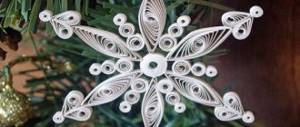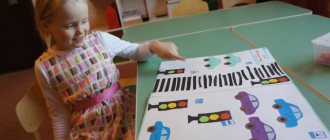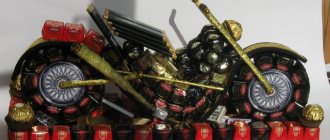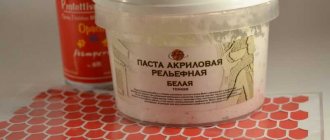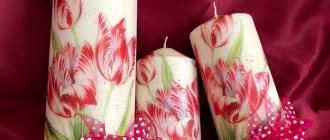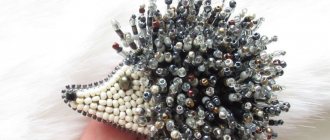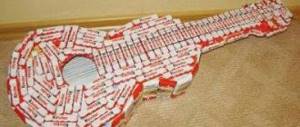I don't know about you, but I always start my day with a cup of coffee. I love this drink with a high head of foam. That's why I like it to have some kind of design on it. It’s especially nice to see a heart on the cap of a coffee – espresso or cappuccino. Previously, I took a strainer in a given shape and sifted the cinnamon through it.
But not everyone likes coffee drinks with this seasoning. Cinnamon goes well with espresso and Americano, but not quite with cappuccino. But it turns out there is a quick and easy way to create a heart directly from milk. Let's learn latte art (drawing from coffee) from the simplest figure. My husband is a coffee lover, and he especially loves cappuccino. It was he who taught me how to make a heart in a cup of homemade cappuccino. And after that you can move on to more complex drawings.
P O P U L A R N O E:
Each of us has our own house. And any bird wants to build a full-fledged house with walls, a roof, etc. Let's help our birds!
Take a board about 200 mm wide and saw off the front and back walls to a length of 300 mm.
We make a gift box out of paper with our own hands.
A homemade gift box is always a nice gift. You can put jewelry for your loved one in such a beautiful box. And now in more detail (with a photo of the master class) about making a box and cute white roses for it.
During quite a short period of use (about 3 months), a popular tool (especially among women) for cleaning floors - a PVA mop with a folding handle - began to malfunction, and then completely broke down... Read more...
What you need for latte art
The right “ink” is the key to a good drawing with clear contours. The milk should be full fat. After all, the dietary product has low density. Therefore, such milk will quickly dissolve in coffee or cappuccino. The higher the fat content, the more stable the foam. But cream is also not suitable. They are heavy and will immediately sink into the cup. Therefore, we take milk with 3.5 percent fat content.
Children no longer ask to buy ice cream: I prepare a dessert in the form of watermelon at home
Better than any dessert. Strawberries become even more flavorful in the oven
Only with scuba diving: cities under water and their brief sad history
We will also need a pitcher. This is a metal jug with a narrow neck. The foam will flow out of it in a very thin stream. To froth milk you will need a steamer. This device is an integral part of modern coffee machines. I don't have one, so I use a regular French press, although it takes a little longer.
Views
- A simple and reliable DIY metal detector - 202,746 views.
- DIY microwave oven repair - 188,512 views.
- Simple DIY metal detector - 183,939 views.
- Charger from a computer power supply. — 182,346 views.
- Car chargers. Scheme. Principle of operation. — 157,109 views.
- A simple and reliable thermostat circuit for an incubator - 146,511 views.
- Simple automatic charger - 112,057 views.
- DIY moonshine still - 109,934 views.
- Variety of simple circuits on NE555 - 104,855 views.
- How to change the USB connector yourself? — 102,685 views.
Preparing the foam
Happy owners of a coffee machine can simply pour milk cooled to 4 degrees into a special steaming container and pour it through the steamer into the pitcher. The surface of the stainless steel jug will give your hand the feeling that the required temperature of 60-62 degrees has been reached: your palm will be hot, but not scalding.
For those who do not have a coffee machine, you need to heat the milk in a saucepan or bowl to the specified temperature. Then pour into a French press and actively move the sleeve up and down. All the milk needs to turn into foam. Pour it into the pitcher. You need to lightly tap the jug on the table a couple of times. This is necessary for the foam to settle and become denser. Rotate the pitcher a little more from side to side. That's it, the “ink” is ready for drawing.
This article will tell you in detail and step by step how to make an original heart-shaped topiary with your own hands, which will have a pleasant aroma of your favorite coffee, with delicate notes of orange and cinnamon! This topiary can become a wonderful decorative element for absolutely any kitchen!
Necessary materials and tools to create a coffee heart: - ceramic pot; — ground coffee (about 50 grams); - coffee beans (approximately 150-200 grams); - universal glue; - wire; - ready-made polystyrene foam in the shape of a heart; - Styrofoam; - burlap; — construction gypsum; — natural raffia; - rattan balls; — cinnamon sticks (2 pieces); - a slice of orange.
The direct process of creating a coffee heart: First stage. The first thing to do is take some wire and twist it into a heart shape. In this case, you will need to make a tail at the bottom so that the wire can stay more tightly in the ceramic pot.
Second phase. At the next stage of work, you need to take a ceramic pot and crumble the foam into small pieces inside it, as shown in the photo below.
Third stage. Then, you will need to take construction plaster and dilute it with water. After the gypsum is diluted in water, it should be poured into a ceramic pot with foam.
Fourth stage. At the next stage of work, you will need to immediately install the prepared wire in the shape of a heart into the prepared gypsum mixture with polystyrene foam.
Fifth stage. After this, it will be necessary to dilute the building gypsum a little more in water, and the resulting mixture will need to be filled with a ceramic pot to the very top.
Sixth stage. At the next stage of work, you will need to take natural raffia and wrap it with wire. But at the same time, the raffia should be constantly glued with glue.
Seventh stage. After the wire is wrapped with raffia, the heart shape should be aligned.
Eighth stage. Then, you will need to wrap the wire completely with raffia, and its end should be secured with glue.
Ninth stage. At this stage of work, you will need to start making a heart-shaped foam blank. If the workpiece is white, then it will need to be pre-painted with brown acrylic paint. It is best to use a soft brush for painting. After the workpiece is completely painted, it will need to be left until the paint dries completely. Tenth stage. Then, you will need to begin gluing coffee beans to the surface of the painted workpiece.
Eleventh stage. The coffee beans should be glued tightly to each other, as shown in the photo below.
Twelfth stage. Coffee beans on the surface of the workpiece can be glued both in one direction and in different directions!
Thirteenth stage. Then, in the middle of the upper part of the heart, you will need to make a hole using an awl.
Fourteenth stage. After this, you will need to pour glue into the hole made and glue the workpiece to the wire.
Fifteenth stage. Then, around the perimeter of the wire heart, you will need to glue individual coffee beans, as shown in the photo below.
Sixteenth stage. Then, you will need to tie a bow from raffia and glue it to the created craft.
Seventeenth stage. At this stage of the work, you will need to coat the dried construction plaster with glue, and then pour a thick layer of ground coffee on top. In this case, you will need to press a little ground coffee with your hands! Eighteenth stage. After the glue has dried well, glue two cinnamon sticks, a dried orange and two rattan balls onto the surface of the ground coffee, as shown in the photo below.
Nineteenth stage. Then, you will need to glue a small piece of burlap onto the front of the ceramic flowerpot. But on the surface of the burlap you will need to glue a slice of dried orange and coffee beans.
Everything, a beautiful and very original coffee tree, which is made by hand, is completely ready!
Good luck!
Similar homemade products:
What can specialists do on the surface of coffee?
An art latte specialist must:
- know thoroughly the rules for preparing espresso, its variants and drinks based on it;
- have a good understanding of coffee blends, recognize coffee varieties, know everything about the principles of growing raw materials, roasting technology, distinguish aromas and taste characteristics;
- be able to evaluate the taste of a drink down to a semitone;
- be able to prepare at least 40 types of coffee, including latte, cappuccino, ristretto, correto, etc.;
- thoroughly master the cooking technique, including grinding balancing, temperature selection, pressure selection, recipe for each portion, etc.;
- draw the most unimaginable patterns and ornaments on the foam.
In order for the drawing to turn out truly beautiful, the master hones his art for hours, or even weeks. Of course, drawing a heart on the surface of a latte is not a problem for a pro, but decorating an espresso with an elaborate pattern is really difficult even for an experienced barista.
Professional ranking has its own highest level - the position of “Master” of coffee, which in terms of importance can be compared with a Doctor of Science (in this case, coffee science).
Another trait that a professional barista aspiring to the title of master will need is tirelessness, because in a day he will have to decorate dozens of servings of cappuccino, latte, espresso, etc. with a heart or a flower.
Return to content
Preparing the drink
To get a beautiful and stable pattern, coffee or cappuccino must also be brewed correctly. Sugar thins the coffee, so you shouldn’t sweeten it—you can do that later. But the main requirement for drinks for latte art is a high head of foam. This is the canvas on which we will paint.
Yuri Bogatyrev hid his only wife from his mother. Now his widow is 76 years old
In June, do not forget to feed the cabbage. Making fertilizer from natural herbs
Structures are not created, but grown: the history of Art Nouveau huts in Hobart
To make the cappuccino heart clearer and more contrasting, you can sprinkle the surface with the drink with cinnamon. But this step may cause the drawing to be short-lived. If you are right-handed, hold the pitcher in your right hand and the cappuccino cup in your left.
Stencil
Stencil drawings, for example, a heart on coffee, are made on thick foam. To do this, you need to properly cook the grains:
- use only fresh ground ones;
- brew in a coffee machine.
Coffee brewed using another method will not have foam, so you will have to use a pitcher.
The stencil can be purchased or homemade. Based on the examples, draw a heart and cut it out in two ways:
- solid;
- thin strip along the contour so that spices or other materials can spill out on the other side.
You need thick cardboard, the diameter of which is larger than the mug. Cut out the heart so that it is smaller than the diameter of the cup.
For powder, a device is suitable that dispenses it in doses so as not to overdo it.
Drawing a heart
Follow the rules below:
- Tilt the cup 45 degrees towards the pitcher.
- Bring the spout of the jug to the far edge of the cup. The distance between the cappuccino foam and the pitcher should be no more than 5 cm.
- Slowly but surely pour the frothed milk, first into the end of the cup farthest from you, moving towards the middle.
- Slow down a little - let enough foam flow out. So the heart will become voluminous.
- Now the key movement. Lift the pitcher and pour out a stream, as if crossing out the formed circle. At this time, place the cup level with your left hand. Thanks to this movement, a stream of foam falling from a greater height will “gather” a puddle around itself, and you will no longer have a circle with coffee stains, but a real heart.
The drawing may not be too good the first time. For me, for example, it looked like a blot. But here you just need to get better at it. Train, drink coffee and train again. In the end, even if you don't become an experienced barista, at least you will enjoy the taste of a great drink.
Found a violation? Report content

